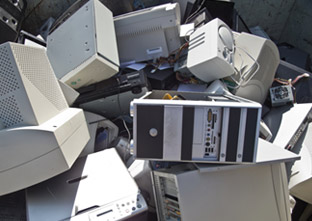Bumpers in recycled plastic: a world-first for Plastic Omnium

You claim to be the first to have come up with recycled plastic bumpers for cars. However, haven't these plastics been in use for years already in the design of cars ?
Of course, and it's a good thing, too! But up till now, parts made from recycled plastic just weren't visible, sometimes even hidden away
These materials were to be found in various casings, technical parts, wheel arch protections…Parts that don't affect the car's overall appearance and which added very little value that area so dear to automotive journalists: perceived quality.

Why is that ?

Simply put, it was very difficult, practically impossible in fact, to create parts with the exact same properties as those made from virgin resin. We were stumped. Either the mechanical properties were fine, or its final appearance was excellent, but we were never able to have both at the same time. We spent years conducting tests and we were never completely happy with the results. Once these parts were painted, they often showed up small aesthetic defects which weren't apparent beforehand. They would have been invisible to the general public but we knew that they would be judged as being unacceptable by those responsible for automotive quality assurance.
And were you finally able to come up with a miracle solution ?
 You could say that, but it was no easy thing. Our first patent was filed in 2007, so we have been working on this for a long time. Plastic Omnium believed in this project, with good reason, and didn't hesitate to invest heavily in research and development to make it a success.
You could say that, but it was no easy thing. Our first patent was filed in 2007, so we have been working on this for a long time. Plastic Omnium believed in this project, with good reason, and didn't hesitate to invest heavily in research and development to make it a success.
The result is up to our expectations as we are now the only ones in the world to offer a recycled plastic with identical properties to those of virgin materials.
What is your secret ?
The first step was selecting the right basic materials for the job. We are very fortunate to be partners with Derichebourg, a heavy-hitter in the world of collecting and sorting of used materials. After that, a lot of work was done with academics such as the INSA's IMP laboratory or the ENSAM in Chambery. Together, we refined the sorting process by opting for polymers which seemed promising for us. Therefore, we chose to go with plastics from recent cars, often recently involved in accidents, household appliances as well as end-of-life electrical and electronic devices and, finally, automobile shredder residue (ASR). This phase was crucial because we need to monitor our process in order to make absolutely sure that our new material will retain its characteristics over time. It is all a matter of dosage and we take great care in this area.

But that's not the end of it ?

It's true. We had to understand how this new material would react, particularly during the moulding phase, after having been washed, shredded and extruded. For the formulation, we put it through a process of reactive extrusion, which means "playing around" with the chemical properties of each material and additives going into our mix. Four years after our first tests, we finally came upon the correct formula which, I'm sure you'll understand, is a closely-guarded secret. It represents long years of research and several patents. This is why we have quite a head-start on our competitors.
Okay, but is there a market for this new polymer ?
 There is because, once again, we have managed the feat of creating a material from end-of-life products which is practically identical to virgin resins. Peugeot was the first manufacturer to join us on this adventure. And when a car manufacturer whose quality standards are so high decides to use our new polymer, it's only because it conforms entirely to their draconian standards - resistance to ageing, shock absorption, final appearance, etc. Today, the back bumper of the new 208 model is manufactured from this new material. One year after going into large-scale production, Peugeot is very proud to announce that the rate of use of recycled plastics in its cars is continually increasing.
There is because, once again, we have managed the feat of creating a material from end-of-life products which is practically identical to virgin resins. Peugeot was the first manufacturer to join us on this adventure. And when a car manufacturer whose quality standards are so high decides to use our new polymer, it's only because it conforms entirely to their draconian standards - resistance to ageing, shock absorption, final appearance, etc. Today, the back bumper of the new 208 model is manufactured from this new material. One year after going into large-scale production, Peugeot is very proud to announce that the rate of use of recycled plastics in its cars is continually increasing.
Good for the image, and good for the planet … but how cost-effective is developing such a resin ?
Above all, this is a long-term investment on the part of Plastic Omnium. This material currently has a higher cost than an untreated material. The solution to this problem will come from an increase in volumes produced. We currently have a large number of possible projects and applications. Taking into account the rising cost of oil and current environmental issues, we are safe in the knowledge that we have here an innovative product which we are the only ones to have marketed at this time.

Are these business opportunities on a global scale ?
 Yes, and we are big enough to be able to promote the product to all in the industry who may be interested in our resin. Including Asia!
Yes, and we are big enough to be able to promote the product to all in the industry who may be interested in our resin. Including Asia!
In fact, Asia as a whole, and more particularly China, which has made its own reputation as the champions of recycling unsorted plastics, are also striving for quality.
By making recycled plastic a high-grade product, we are attracting a great number of industries who see it as a means of giving themselves a greener image, but also as a way of increasing productivity.
Will you improve the system for collection and sorting ?

It isn't our main job, but we would nevertheless like to contribute to its improvement. We know that we'll be able to count on the support of Derichebourg and our scientific partners to achieve this. The possibility of manufacturing a high-end material from recycled plastic is a motivation for collectors, who see it as a way of promoting their business while increasing their profitability. We are currently taking part in a very ambitious competiveness cluster project whose end-goal is to establish good channels for collection, across all industries, so that all reusable materials can be carefully sorted and, of course, reused. As for the other types of materials, we are pushing for them to be recovered and used for energy rather than being buried. We have given ourselves five years to achieve this!
Frédéric Viot
 52 years old,
52 years old,
Doctoral Degree in organic chemistry,
Four years in pharmaceutical research,
Approximately 20 years in the automotive industry, of which 10 in recycling and Ecodesign more specifically (8 patents and numerous conferences, courses and publications)
Plastic Omnium
Plastic Omnium is composed of two divisions
The PO Automotive division, world leader in automobile body and structural parts, fuel systems and pollution control systems
The PO Environment division, world leader in equipment and services for waste management and urban planning
CREER: Cluster Research : Excellence in Ecodesign and Recycling. Approximately 60 members across all industries. A dozen projects whose main goal is to mainstream good practices in terms of recycling and Ecodesign (website: http://www.clustercreer.com)





